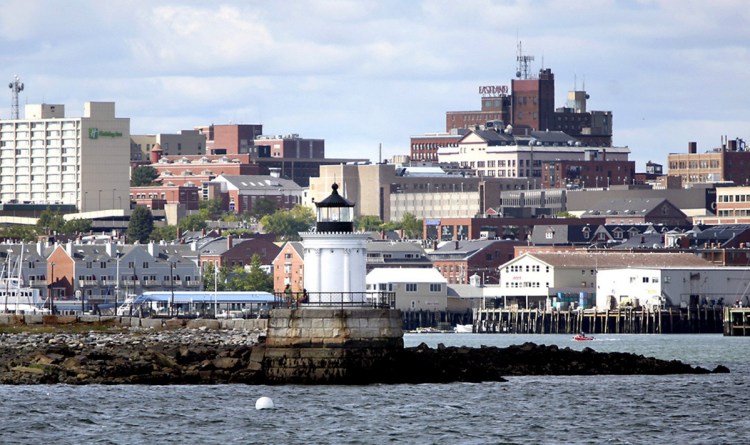More than 30 Maine communities, some with surprisingly upscale neighborhoods, could reap benefits from a new federal program to encourage private investment in poor parts of the country.
Opportunity zones selected by Gov. Paul LePage and approved by the U.S. Treasury include distressed paper mill towns such as Madison and Millinocket and former military bases in Brunswick and Limestone, but also comparatively better-off parts of Portland, South Portland and Saco.
The opportunity zone program was created by the $1.5 trillion tax bill passed by Republicans last year. The program allows investors to create so-called “opportunity funds” through which they can reinvest capital gains – profits from the sale of investments – into designated areas tax-free for up to 10 years, then get a 15 percent tax break on the initial investment. Any profits they make annually through the investment are tax-free.
The money could be put into commercial projects, startup companies and real estate.
Some analysts think the lightly regulated program could unlock hundreds of billions of dollars from investors who are hesitant to cash out of investments because of capital gains taxes. But critics worry the program will give tax breaks to wealthy investors to spend on high-end real estate and other projects that don’t benefit poor neighborhoods, and that the administration is misusing the zones to give tax breaks to projects already in development or to steer money into gentrifying neighborhoods.
“The intention was to spur investment that would not otherwise take place by offering these incentives,” said James Myall, a policy analyst with the left-leaning Maine Center for Economic Policy. “If the (state) wants to take the position that they were looking for places that already had projects, that is concerning.”
Critics further worry about a lack of program oversight. Investors only have to complete a form with their federal tax return to qualify for an opportunity fund program. The Internal Revenue Service has not completed its regulations, but there are currently no requirements for job creation or economic growth to justify a tax break.
The LePage administration tried to strike a balance, said Doug Ray, spokesman for the Department of Economic and Community Development, between very poor tracts that may struggle to attract investment, and tracts where there was already some economic activity and are more attractive to investors. The department took suggestions from communities and economic development groups, but also looked at an area’s population, employment data, available commercial real estate and pending developments. The state selected 32 tracts – about 25 percent of eligible low-income census tracts in the state, the limit allowed under the federal program.
“I think we tried to be cognizant of where the need was to where we had a realistic chance of success,” Ray said. “If you put these (zones) where there aren’t any businesses or likely opportunities, the chance of an investor steering funds there are a lot lower than they are where there is a likelihood of success.”
The zones selected by LePage are mostly in parts of northern and eastern Maine with long-standing economic problems. They include communities dependent on forest products, such as Millinocket and East Millinocket, Lincoln, Old Town and Rumford, and a cluster of Washington County towns such as Baileyville and Calais. Parts of central Maine cities such as Lewiston, Auburn, Waterville and Augusta also could benefit.
A minority of zones selected by LePage are in parts of Maine with booming economies and high real estate prices, yet still part of low-income census tracts. Those include downtown Portland, the Maine Mall area in South Portland, a part of Westbrook where a massive retail development is planned, and a commercial corridor in Saco.
Even though opportunity zones are untested, Portland officials think the program could draw money into waterfront projects like a cold storage facility at the International Marine Terminal.
The 10-year waiting period before real tax benefits are realized should prevent short-term real estate speculation, said Jeff Levine, Portland’s planning and urban development director.
“It is not for someone who is just in it to make a profit and flip a property, it is for someone who wants to invest in an area for a long time,” Levine said.
Investors already are beginning to think about possibilities in opportunity zones, said Kris Eimicke, a tax attorney with Pierce Atwood. Eimicke spent Sunday afternoon sorting through census tracts to help prospective clients find investment options.
Even though money is flowing into southern Maine, opportunity zones could bring in more, Eimicke said. Funding also might benefit new companies that don’t have extensive physical assets, he said.
“It could definitely be used for startups,” Eimicke said. “Portland is the center of Maine’s startup economy for those groups looking for angel investors. Being able to give them an access to capital could be huge.”
The federal legislation that established the tax overhaul severely limits where opportunity zones could be sited – in Maine’s case, officials could only select 32 of 128 eligible census tracts.
That will leave some communities wondering why they didn’t make the cut, said Peter DelGreco, president and CEO of Maine and Co., which works to attract businesses to the state.
“New investment that can come anywhere in the state, we are going to be excited for it,” he said. “If any of these places are able to use this program to generate new economic growth, then it will be a success.”
Peter McGuire can be contacted at 791-6325 or at:
pmcguire@pressherald.com
Twitter: @PeteL_McGuire
Send questions/comments to the editors.



